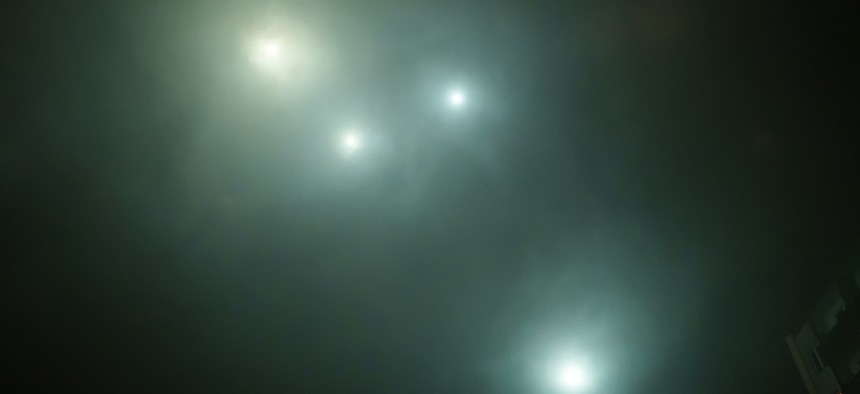Pentagon Watchdog to Examine How the U.S. Military Handles UFOs

M-Production/iStock.com
The inspector general launched an evaluation into “actions regarding Unidentified Aerial Phenomena” just before a similar report is due to Congress.
The Pentagon’s watchdog is formally evaluating moves the Defense Department has made in connection to sightings of the unexplainable—ahem, unidentified flying objects—in military airspace.
In a memorandum issued Monday to top department leaders, Assistant Inspector General for Evaluations on Space, Intelligence, Engineering and Oversight Randolph Stone confirmed a new probe and its primary objective: “to determine the extent to which the DOD has taken actions regarding Unidentified Aerial Phenomena (UAP).”
This work will be performed at the Offices of the Secretary of Defense, military services, combatant commands, combat support agencies, defense agencies, and the military criminal investigative organizations, Stone said. Other locations may be added as the evaluation rolls out.
The examination appears to have a broad reach. The IG sent the memo to the chairman of the Joint Chiefs of Staff, the secretaries of the military services, select commands, military intelligence agencies, the Under Secretary of Defense for Research and Engineering and the directors of the Defense Advanced Research Projects Agency and the Defense Technology Security Administration. They were all given a five-day deadline to respond with a point of contact for the review.
“We may revise the objective as the evaluation proceeds, and we will consider suggestions from management for additional or revised objectives,” Stone wrote.
The IG launched this evaluation a little over a month before when Congress expects to receive a report compiled by personnel from various federal entities with deep analyses specifically on existing data and reports of UAPs. Human, geospatial and intelligence signals might be included in the accounts, which were mandated through a push from senators in late 2020.
Observances of unknown, strange and sophisticated airborne objects and occurrences have been recorded by U.S. pilots and other military members for decades now. In August, the Pentagon formed the Unidentified Aerial Phenomena Task Force to “gain insight into the nature and origins of UAPs.” That unit came after the Advanced Aerospace Threat Identification Program, or AATIP, which secured Congressional funding with support from former Senate Majority Leader Harry Reid, D-Nev., years before it came to light in 2017.
The Debrief first reported this new memo, in a write-up that also suggested the office’s decision was spurred by complaints from legislative leaders with concerns about how the Pentagon has been confronting this UAP issue.
Whistleblowers and lawmakers can spark watchdog investigations and evaluations, but a spokesperson from the IG’s office would not elaborate on the roots of this one. The “memo contains all that we are able to say on our evaluation,” they told Nextgov in an email Wednesday.
The evaluation’s announcement also comes a week after Reid released his own letter confirming that former intelligence officer Luis Elizondo was involved in the Pentagon’s former group, the AATIP. Elizondo went public first in 2017 about that earlier UFO-investigating hub’s work, but more recently the DOD essentially said he didn’t have assigned responsibilities within the program at a given period.
Though he didn’t get into specifics, in a briefing with Nextgov and other reporters earlier this year, Elizondo shed some light on the encounters and evidence that are mysterious, unexplainable—and that the government already has privy to.
“I think for me, the most concerning—not the most compelling, but the most concerning—are those incidents that involve our nuclear equities. There seems to be a very distinct congruency between UAP-associated activity and our nuclear technology, whether it be propulsion or weapon systems or whatnot, and that's concerning to the point where we've actually had some of our nuclear capabilities disabled by these things,” he said at the time. “So, let's put this in the context of foreign adversarial technology. If Russia or China had the ability to disable our nuclear strike capability or defense capability, that's pretty significant. That's a concern.”
On Wednesday, Elizondo told Nextgov in an email that he wouldn’t be surprised if additional inquiries result from this OIG evaluation.
“[It] should be a wakeup call to the few remaining pockets of individuals resisting transparency in the Pentagon,” he said. “There still remains a small cadre who are attempting to hide the truth from the American people.”
Reid expressed approval of the evaluation to Mystery Wire on Tuesday and noted that the IG can access more resources than the UAP Task Force alone.
“The Inspector General’s office has almost unlimited power to get to the bottom of things within DOD,” Reid said.
RELATED PODCAST






